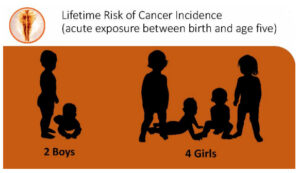REFERENCE GIRL: Why we need her now.
Founded by renown biologist and dedicated researcher, Mary Olson, GRIP was born in the independent finding that ionizing radiation (IR) has dramatically higher rates of harm to female bodies than to males.
Gender and Radiation Impact Project (GRIP) was born in the independent finding that ionizing radiation has dramatically higher rates of harm to female bodies than to males.1 GRIP is committed to deeper understanding of these differences, and to better radiation protection and exposure prevention for the entire life-cycle.
A first step would be to swap a Reference Girl for the Reference Man currently used by radiation regulators to define radiation harm, to calculate exposures and determine compliance with public safety requirements.
A year‐long project to create the parameters for Reference Girl, would include consultation with colleagues, drafting the proposed Reference as a first‐step towards greater radiation protection, and communicating this proposal. Deliverables include: documentation of expert consultations: paper to be submitted for publication; multiple blog posts during these processes; webinar slides and recorded version.
“Finding these patterns does not make them new. Ionizing radiation inflicts disproportionate harm to girls and women compared to boys and men, and the
difference is not trivial. It is time to update policy to protect everyone better.” Mary Olson
GRIP is committed to deeper understanding of these differences and enhancing radiation protection and exposure prevention for the entire human life-cycle.
- Create chart and impact guide reflecting existing data on IR genetic impacts that clearly shows more risk females than male examples currently referenced.
- Add a female Reference Girl to the Reference Man currently used by radiation regulators to define it’s harm, to calculate exposures.
- GRIP supports new research on gender as a factor in radiation harm and the application of findings to practices and policies for greater public health and protection.

Reference Girl Matters.
Following the data clearly shows that her time is now.
“REFERENCE MAN” is used for generic evaluation of Ionizing Radiation (IR) impacts, industry regulation, and nuclear licensing decisions made by the US Nuclear Regulatory Commission (US NRC 2018), influencing it’s use and adaptation globally.
- Findings from sixty years of A-bomb survivor data show that Reference Man does not represent the human life cycle with respect to harm from radiation exposure.
PROTECTION AND PREVENTION OPPORTUNITIES
- Existing reports are clear, females are more harmed by radiation, particularly when exposed as young girls, than is predicted by use of Reference Man; by as much as ten-fold.
- Largely invisible to decision-makers, the time is now this relevant information on the disproportionate harm to females be more widely distributed.

A portion of this work was published by Mary Olson under the title, ‘Atomic Radiation is More Harmful to Women’ (2011) and presented at: U.N. World Conference in Vienna on the Humanitarian Impacts of Nuclear Weapons. Olson, 2014
Gender and Radiation Impact Project (GRIP) is poised to develop a new, more protective model for public radiation standards.
“Reference Man is used to predict cancer outcomes from a release of radioactivity, and this estimate is ten-times lower than if the regulators based their calculations on the impacts to a young girl. This means that global evaluation of the impact of radiation is off, way off. “ – Mary Olson
Ionizing radiation is hazardous. Very high levels are lethal and even a single radioactive emission has the potential to cause a fatal cancer, or loss of a pregnancy.
Atomic radiation is most harmful to young girls and females of every age have a higher risk of radiation harm than males of the same age. No public protection standard is based on girls. In the USA, regulations are based on a “Reference Man” who, it turns out, is the most radiation-resistant part of our lifecycle. Men are harmed by radiation, but less than everyone else—a lot less. There is as much as ten times more cancer caused by radiation in the women of the world because protection standards are not based on us.
GRIP will draft a proposal for “Reference Girl” in 2021, through a robust and documented consultative process, and introduce her to regulators at the global and national level. We’ll share her with anyone interested in better protection from the hazards of ionizing radiation, for this and future generations. Nonetheless…
Reference Girl is only a first step.
GENDER AND RADIATION PROJECT 2021
- Announce Consultation
- Begin Blog—which will continue throughout the year with monthly posts
- Meet with interested parties, experts, current and previous regulators, researchers, medical and developmental experts and document these meetings
- Draft parameters for Proposed Reference Girl
- Circulate draft for expert review
- Recruit her posse of Opinion Leaders who will “have her back” as she is sent out into the world
- Send Proposed Reference Girl parameters to expert bodies including the UNSCEAR Cancer Panel, ICRP, US National Academy of Science, Global Gender Summit, federal agencies in the USA and other bodies and agencies
- Create Webinar for communication of Reference Girl
- Write paper for peer review and publication
- Develop strategic plan to promote Reference Girl in 2022 and plan to develop protection of reproduction and reduction of infertility due to ionizing radiation
Get a GRIP!
The Disproportionate Negative Impact of Radiation and Radiation Regulation on Women and Girls
The mission of the Gender and Radiation Impact Project (GRIP) is to:
- Promote a better understanding of how harm from ionizing radiation is related to gender and age at the time of exposure,
- Encourage research that clarifies these relationships, and
- Advocate for safety standards and regulations solidly based on this research.
